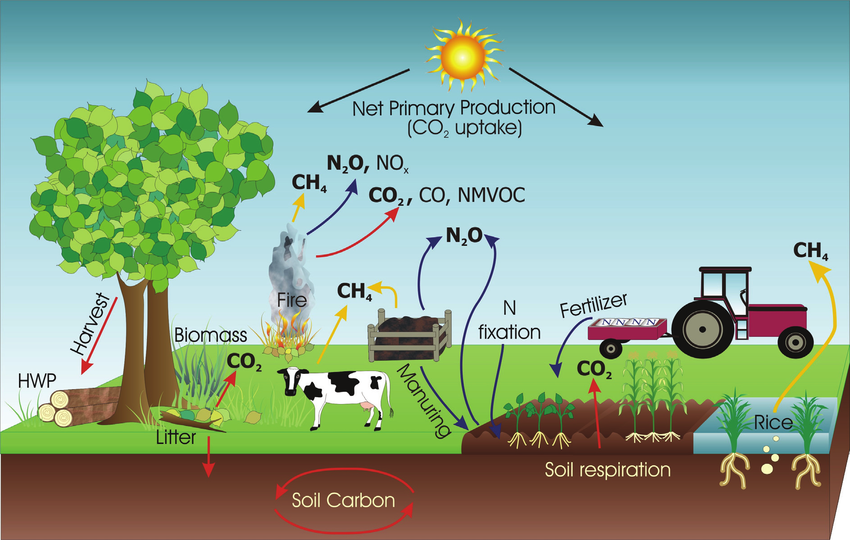Greenhouse gases (GHGs) are essential components of the Earth’s atmosphere, playing a critical role in regulating the planet’s temperature. However, human activities have significantly increased the concentration of these gases, leading to global warming and climate change. This article explores the science behind greenhouse gases, their sources, and their impact on the environment.
What are Greenhouse Gases?
Greenhouse gases are atmospheric gases that trap heat from the sun, preventing it from escaping back into space. This process is known as the greenhouse effect, which keeps the Earth warm enough to support life. The main greenhouse gases include carbon dioxide (CO2), methane (CH4), nitrous oxide (N2O), and fluorinated gases.
Key Greenhouse Gases and Their Sources
Carbon Dioxide (CO2)
Sources: CO2 is released primarily from the burning of fossil fuels (coal, oil, and natural gas), deforestation, and industrial processes like cement production. It is the most abundant greenhouse gas and has the longest-lasting impact on climate.
Impact: CO2 is responsible for about 76% of human-caused global greenhouse gas emissions. Its long atmospheric lifespan means that CO2 emissions have a lasting impact on the climate.
Methane (CH4)
Sources: Methane is released during the production and transport of coal, oil, and natural gas. It also comes from livestock and other agricultural practices, as well as the decay of organic waste in landfills.
Impact: Methane is more than 25 times more effective at trapping heat in the atmosphere than CO2 over a 100-year period. Although it has a shorter atmospheric lifespan, its potency makes it a critical contributor to global warming.
Nitrous Oxide (N2O)
Sources: Nitrous oxide emissions come from agricultural and industrial activities, as well as the combustion of fossil fuels and biomass. The use of synthetic fertilizers in agriculture is a major source of N2O.
Impact: Nitrous oxide is about 300 times more effective at trapping heat than CO2 and can stay in the atmosphere for over 100 years.
Fluorinated Gases
Sources: Fluorinated gases, including hydrofluorocarbons (HFCs), perfluorocarbons (PFCs), and sulfur hexafluoride (SF6), are synthetic gases used in industrial applications, refrigeration, and air conditioning.
Impact: Although less common, fluorinated gases are extremely potent greenhouse gases with a significant warming effect. They can stay in the atmosphere for thousands of years.

Image: Andre Van Amstel
The Greenhouse Effect
The greenhouse effect is a natural process that warms the Earth’s surface. When the sun’s energy reaches the Earth, some of it is reflected back to space, while the rest is absorbed and re-radiated by greenhouse gases. This trapped heat warms the Earth’s surface, making it habitable. However, human activities have intensified the greenhouse effect, leading to an increase in global temperatures.
The Impact of Increased Greenhouse Gases
Global Warming: The rise in greenhouse gas concentrations, particularly CO2, has led to a significant increase in global temperatures. This warming contributes to a wide range of environmental changes, including melting polar ice, rising sea levels, and more frequent extreme weather events.
Ocean Acidification: The oceans absorb about one-quarter of the CO2 emitted into the atmosphere. This process leads to ocean acidification, which affects marine life, particularly species that rely on calcium carbonate for their shells and skeletons.
Ecosystem Disruption: Increased temperatures and changing weather patterns disrupt ecosystems, affecting biodiversity. Species may struggle to adapt to the rapid changes, leading to shifts in population dynamics and habitat loss.
Human Health and Agriculture: The impacts of greenhouse gases also extend to human health and agriculture. Heatwaves, air pollution, and changing precipitation patterns affect crop yields and increase the spread of diseases.
Mitigating Greenhouse Gas Emissions
Transitioning to Renewable Energy: Shifting from fossil fuels to renewable energy sources like solar, wind, and hydroelectric power is crucial in reducing CO2 emissions. Renewable energy not only reduces greenhouse gas emissions but also promotes energy security and creates jobs.
Energy Efficiency: Improving energy efficiency in buildings, transportation, and industry can significantly reduce greenhouse gas emissions. Simple measures like using energy-efficient appliances and improving insulation can make a big difference.
Carbon Capture and Storage (CCS): Carbon capture and storage technologies can capture CO2 emissions from power plants and industrial processes, preventing them from entering the atmosphere. These technologies are essential for reducing emissions from sectors that are difficult to decarbonize.
Sustainable Agriculture: Adopting sustainable agricultural practices, such as reducing synthetic fertilizer use and improving soil management, can help lower nitrous oxide emissions. Methane emissions from livestock can be reduced by improving feed efficiency and manure management.
Policy and Regulation: Governments play a critical role in regulating greenhouse gas emissions through policies such as carbon pricing, emission reduction targets, and support for clean energy initiatives. International agreements like the Paris Agreement aim to unite countries in the global effort to combat climate change.
Greenhouse gases are essential to life on Earth, but the rapid increase in their concentration due to human activities poses a significant threat to our planet. By understanding the sources and impacts of greenhouse gases, we can take informed actions to reduce emissions and mitigate the effects of climate change. Transitioning to renewable energy, improving energy efficiency, and adopting sustainable practices are key steps toward a more sustainable future.
Author
Ziara Walter Akari
© www.apotheosislife.com
